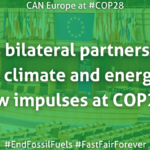Which European Directive links EDF, HSBC, Siemens and your local primary school? Or, roof insulation, power lines, light bulbs and the local council?
The answer is the Energy Efficiency Directive (EED). With a coverage and complexity that has led to it being described by one European official as “basically eight Directives in one,” it’s no wonder that the EED has attracted a record number of over 2200 proposed amendments in the European Parliament.
This deluge reflects the interest the draft Directive has attracted since the proposal, intended to ensure delivery of the EU’s 20% energy saving target, was published in June 2011. Following Member State hostility to the idea of binding targets, the European Commission presented a proposal that requires governments to adopt self-selected national targets on a merely suggestive basis. It also outlines sectoral measures to address energy companies, public authorities and large companies.
But, there is still a long way to go before the law’s final form is established. The 27 Member States making up the European Council, and the European Parliament both still need to determine their own positions, before reaching a common agreement. The two institutions are aiming to reach this point by mid 2012 -but it is shaping up to be quite a battle.
Central to discussions are the relative roles of targets and measures. Should Member States:
- adopt binding national targets, with complete flexibility over how to meet them,
- remove targets, and instead beef up measures such as obligations on energy suppliers, targets and standards for renovating public buildings, and requirements to combine heat and power production,
- or, have both: targets to provide focus and planning certainty, and measures to help overcome the barriers that have impeded energy savings in the past?
What everyone agrees is that some combination of the above is needed: at current rates of progress – and with existing laws – the EU will miss its target to cut energy consumption by 2020 by at least half.
As things stand, the European Council are looking to substantially weaken the draft Directive. Most Member States are maintaining a strong resistance to binding targets, at the same time as seeking to water down most of the Commission’s suggestions for specific measures. Meanwhile the European Parliament is tending towards strengthening the proposal, with the Environment Committee already having voted in December to support binding targets as well as tighter sectoral provisions.
CAN-Europe believes that a Directive capable of delivering the 20% target will need both binding targets and strong obligations on energy companies. These will provide and catalyse the delivery and financing mechanisms needed to achieve these targets. Given the weak nature of current EU policy on buildings, it is also vital that the new Directive stimulate far-reaching renovation of Europe’s building stock,
The final outcome is as yet far from certain, but the strength of the fight is becoming ever clearer!


